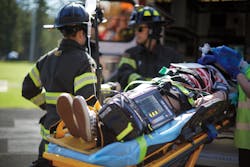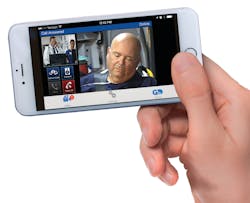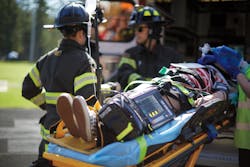EMS providers: Welcome to a future in which technological innovation isn’t just cellphones and electric vehicles. Exciting advancements in EMS have opened the doors to improved communication and patient reporting between the boots on the ground and hospitals. These technologies no doubt will increase organizational effectiveness in the areas of operations and response.
Real-time, two-way communications
Modularity might be the preferred packaging of the future. If so, the Philips Tempus ALS monitor/defibrillator system exemplifies that.
Philips’ separation of the monitor from the defibrillator allows engineers to bypass governmental red tape. This means that they can keep pace with technological advancements and stay ahead of the game. Removing the communications hub from the defibrillator enables quicker innovation than otherwise would be possible.
The real wow factor of the Tempus ALS monitor is the advent of the IntelliSpace Corsium data management system and web-based clinical dashboard. EMS providers can stream vitals, waveforms and images in real time to nurses and doctors, who can watch what’s happening, including medical interventions that paramedics put into play.
Brian Park, who is the EMS coordinator with the Rockford, IL, Fire Department (RFD), has used the Tempus ALS for a year.
All seven of the RFD’s ambulances use the Tempus ALS system. That said, Park notes that his department hasn’t even scraped the tip of the iceberg when it comes to the Tempus ALS system’s capabilities. Hospitals that are in the Rockford area have experienced under-resourced emergency rooms, which slowed implementation and training on a larger scale. Speaking figuratively, Park says, “There isn’t enough bandwidth to adopt this stuff. [The ER staff] need a full court press of support from their administration.”
Park is hopeful that there will be a full partnership between the hospitals and the prehospital providers, so this particular technology can have a significant direct effect on patient outcomes.
Noteworthy additions to the Tempus ALS system are the video laryngoscopy and ultrasound and vascular examinations.
“If we use this right, we can do a lot to improve patient care,” Park says.
Philips tells us that use of proprietary encryption and data transmission technologies permits secure, real-time sharing of clinical data, vitals and images. Rapid clinical and transport decision support and seamless ePCR (electronic Patient Care Report) integration results.First responder/ER interaction
The partnership between prehospital and emergency room staff often can be tenuous when it comes to giving inbound patient reports.
To streamline and perhaps ease tensions between ER staff and first responders, a suburban Chicago medical system pilot program uses the e-Bridge app. It allows ambulance personnel to share HIPAA-secure voice, text, photographs, data and video clips and to stream live using a smartphone, tablet, Toughbook or PC. It also can record and log for quality assessment, training and medical-legal documentation.
General Devices, which developed the app, claims that it allows speedy multimedia communication with EMS providers and hospitals, to improve decision-making and to enhance situational awareness.
Lt. Dan Czaruk, who is the EMS coordinator of the Elburn & Countryside Fire Protection District in Elburn, IL, began using the app on BLS, stroke alerts and trauma alerts at the end of 2022. Czaruk says the app facilitates “cutting out the fluff on transports.”
The app’s ease of use boils down to pushing a few buttons, which is a far cry from the several minutes that first responders spend giving an inbound radio report to emergency room staff, waiting for a room assignment and receiving medical orders.
The app allows paramedics to communicate with the hospital using an electronic fillable form. The form is sent electronically to the receiving hospital, which eliminates the inbound radio or phone report. The receiving hospital then acknowledges the call with the push of a button and can give treatment orders via two-way communication, much like a text message. The app also has a map and real-time image of the responding medic unit, so ETA is known.
Czaruk cites a positive shift in the medic/ER staff relationship.Technology & stroke
A widely accepted technological change in the world of medicine that emerged from the COVID pandemic is the utilization of telemedicine.
Two suburban Chicago departments that work with Rush University Medical Center connect with an on-call neurologist on a regular basis.
Over the past year, when Audrey Enlow of the Bristol Kendall Fire Protection District (BKFD) in Yorkville, IL conducts her rig check, she turns on the laptop in her ambulance that operates a Telestroke program. (All of the BKFD’s ambulances have a fixed Telestroke unit on board.) The Telestroke screen allows two-way communication between first responders who are in the back of an ambulance and an on-call neurologist who is based at Rush University Medical Center.
When a stroke is suspected, paramedics call the neurologist on the phone to initiate the process, Enlow explains. Once contacted, the neurologist will “beam in” on the laptop or tablet and begin the stroke assessment with the help of the treating paramedic.
Enlow says an assessment can be completed before the ambulance reaches the hospital. When that’s the case, the patient often is able to go directly to CT, bypassing the emergency room and saving precious time.
However, as with any new technology, Telestroke isn’t without its frustrations.
The program relies on strong cellular or Wi-Fi availability. Enlow concedes that there are a handful of geographical locations that Telestroke doesn’t work for her and her fellow BKFD paramedics.
“If it improves patient-to-doctor time, that’s good, but they have a long way to go,” Enlow says.
Dr. Alejandro Vargas, who is an assistant professor with Rush University Medical Center, heads up the hospital’s Telestroke project. He concedes to Firehouse Magazine that there are growing pains. This includes dropped calls and dead spots, in which an ambulance might lose connection en route to the hospital, but that’s happening fewer and fewer times, Vargas says.
Vargas is hopeful that Telestroke will become a complementary project to the Mobile Stroke Unit (MSU), offering early stroke recognition to less-populated areas that might not be capable of supporting the $1 million-per-year price tag that’s associated with the operation of an MSU.
“If you have longer transport times, this is a good complement to those patients that need a higher level of care,” Vargas says.
Referencing a recent study of 35 patients who were diagnosed via a Telestroke-like program and 35 patients assessed in a hospital, Vargas says the teleneurologist didn’t miss a single stroke diagnosis.
About the Author

Kristen Wade
Kristen Wade is a battalion chief and EMS program manager with the Sugar Grove, IL, Fire Protection District and is in charge of an engine and ambulance company. She has nearly two decades of experience in the fire service and 15 years of experience as an Illinois licensed paramedic. Wade served as an instructor for the Illinois Fire Service Institute’s fire officer program. She is certified by Illinois Firefighter Peer Support. The organization focuses on the mental health and wellness of EMS and fire personnel. She obtained a bachelor’s degree in English communications from Fort Lewis College.


